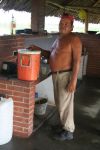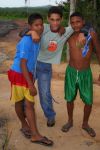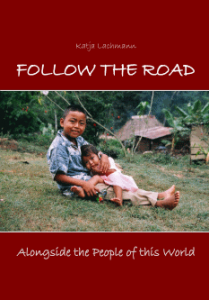From Caracas to Caracas (May 31 – June 26)
June 25, 2007
Topics: Venezuela
We arrived to Caracas on May 31. The airport is a big mess, full of guys offering to exchange money and transportation service. As we did not know there is a black market for money exchange (rate $1 – 3600 Bolivar), we changed on the airport for the official, and thus bad rate: $1 for 2150 Bolivar. Life was expensive the first days, due to this change. A bread cost us easily 4 Dollars that way.
Caracas is a huge, grey, polluted city with, as people say, a high potential for robbery and more unpleasant experiences. Our friend suggested to take as much as nothing with us, whos advice we followed to feel more relaxed walking around. We also left our passports at home, and instead took a copy along.
During our stay a lot of demonstrations in favour and against president Chavez took place. The city is full of red propaganda – t-shirts, governmental posters, as it is a color of Chavez and his revolution. On the other side students were demonstrating against the government politics, closure of opposition TV channel RCTV.
In a whole, staying in Caracas was nice. Probably because we were hosted by a group of University students (from France, Germany and Venezuela) in a 4-room appartment, where the happiness and relaxed atmosphere was always there.
Six days in Caracas were sufficient to overcome the jetlag. Thus we decided to leave for Sucre province. Hitch-hiking that direction was Ok. Apart for that we got a bus ride for free, we were invited for lunch, received 5000 Bolivar as a gift, and managed to stay at a hostel at Cumana bus station, although all rooms have been already taken. We arrived the next day in Punta Arenas, which lays in the Peninsula de Araya, in Sucre province, North-East of Venezuela. There we enjoyed staying in a kind of Robinzone Crouse like posada (hostel) for three days, following an invitation of Rimas, a Venezuelan Lithuanian, whom we met in Caracas. The could stay for free, and we enjoyed the company of Arquimedes (owner of posada), who is a nature and history lover, and a writer all life long. He is still typing with an old type-writer… Imagine!
The peninsula Araya is a dry region, with hardly more vegetation than cactus and spike trees. Fishing seems to be the only way to survive there. In Punta Arenas we enjoyed a great room and
the beach with crystal-clear waters. Hippie, one of Arquimedes dogs, was following us often to the beach. He was getting bored soon, as he did not like to enter water. Spending time on the beach without a shadow did not seem to be a real pleasure for this dog either. Instead he preferred to chase the neighbours bulldog, which was of enormous size, barking aggressive, but – which Hippie knew well – behind the fence. Thus with pleasure he passed by neighbours, showing his teeth, which rather looked like a big grin, rising his leg delightful, and peeing right inside the gate.
We also visited the salt lake and factory of Araya, as well as the castle, which was built 400 years ago.
From Punta Arenas we travelled to San Juan de las Galdonas. Hitch-hiking was not too difficult, transport is rare though. It was funny to get a lift from a Galdonas family descendant, the ones who founded the village of San Juan de las Galdonas. Unfortunately, he was on a different route. The only unpleasant moments were, when we were told about the big narcotraffic along the coast. We had to be careful, but happily nothing happened. We even survived a night right on a crossroad, pitching our tent under the roof of a house, not far from San Juan, which is one of the hot-spots for drug trafficking.
In San Juan we delivered a letter to one lady given to us by Arquimedes in Punta Arenas. After seeing for the first time in our life pink and purple chicks, we immediately set off towards La Cueva del Guacharo (cave of guacharo bird), near Caripe in Monagas province. A miracle made us arrive the same day exactly at the time guacharos, night birds, leaves their cave. Thousands of birds are flying into freedom at this time of the day. They travel trough the national park in search for a food. This is the only night-bird in the world which eats fruits of certain trees, and not insects. We camped opposite the cave, being able to watch the guacharos appearance in the dark sky.
The visit to the cave in the morning was special, knowing that Alexander Humboldt, a German scientist, brought the knowledge about the cave to the world. We went 1200 m inside the cave, the limit for any average visitor. Humboldt could go inside only 420 meters, due to some reasons. Some are saying that only for that disctance the sunlight was comming inside the cave, others guess that the cave was controled by indigenous people, who would not let Humboldt to go further. Guacharos live in the first 800 m. This part of the cave has a smell of rotten fruits and bird excrements. It was hard to bear the birds itself. We were surrounded by the noise of many thousands guacharos, hiding in their nests along the cave walls. In the cave it is completely dark, only the guide is lightning the way with a gas lamp. Later we entered a part where no cucharos live, which is a very quite area of the cave. We enjoyed the different formations formed over millions of years, and laughed to the different descriptions given to some of them by our guide.
Out of the cave we headed for Maturin. We got a ride by a lawyer Alvaro which was on the way to that city. We were hungry, but due to the rain in the last village, also a certain laziness, we did not buy any snack. What a luck – our driver offered pineapple slices, and even bought a couple of hot arepas (corn bread), which filled our stomachs.
Standing at a big gas station in the South of Maturin for continuing towards Ciudad Bolivar, a strong rain kept us inside a petrol station restaurant for a while. Two girls renting mobile phones were curious asking us, “Are you hippies?”. In a way we had to agree, and when we were about to leave, these little girls gave us their beautiful mobile phone bag, which was actually a little monkey puppet.
The next ride was a lucky one. Two young man invited us to stay at their farm near El Silencio, about 4 km far from the main road. Over there we got to know a couple of old men, working for years in agriculture. Dressed only with
pants they served us rice and plantain. We stayed dry that night, enjoying the big roof under which we placed our tent. In the morning we saw two armadillos, already cooked laying beside the sink. “Happy breakfast!”, we thought. We preferred the noodles the cook prepared for us together with yucca.
We set off towards Ciudad Bolivar, having luck as some visitors at the farm brought us right to a gas station. In a few minutes we got a ride by a truck delivering pine trees. He brought us to Chaguaramas, where he organized us another pine tree truck towards Ciudad Bolivar. An old, two seat truck without additional cabin or bed to sit on. Somehow we managed to fit our backpacks inside, and share only one seat. Unbelievable but true, we went right through the forest with him. Along wet, sandy roads full of holes filled to the top with rain water, brought us an average speed of 20km/h. “It is faster than taking the main, well-paved road to Ciudad Bolivar.” – he stayed firm with his opinion. Anyway, we enjoyed this other kind of ride a lot. In the middle of the forest our driver organized a changing to another truck, as this one would bring us faster to where we aimed to go.
Arriving in Soledad, at the other side of the river, directly opposite Ciudad Bolivar, we intended to camp overnight. We were about to go and search for an internet cafe, but a woman seller of the shop, in front which we got out of the truck, warned us. “They will kill you! Do not go anywhere. Get a taxi and head to Ciudad Bolivar!” She was serious. Mhh… We followed her advice, and within half an hour we got out in front of the central bus station in Ciudad Bolivar. We searched for accommodation for the night, as wild camping in a city is difficult. We found a nice place outside of town. A driver picked us up an hour later and we went to the paradise.
The hostel with a huge garden and several cabins provided a great, roof covered place for our tent. We had lots of nature around, even monkeys, a porcupine, a roebuck, and a couple of ducks around, all in cages, unfortunately. Other birds were free like the wind and a pleasure to watch. Additionally, dogs liked us, and we made friends with three little boys, whom were playing all day long in the area. We were so tired and lazy that we ended up staying there for three nights, before continuing towards Caicara.
Hitch-hiking to Caicara seemed a farce. We did not move much, and had to stay the first day kind of on the road. Happily we were offered a half-functioning roof to camp, could cook and enjoyed the company of a handful teenagers. One of them explained us how to hitch-hike successfully. “Take a gun, point it to the car, and say, ‘give me a ride!'” One way to get a ride… He was right. Hearing that his father works in mining diamonds and gold, we understood the thoughtless idea.
The following day, the same difficulties. Until in one very small village we were picked up by Guardia National (army) officer, who works in Puerto Ayacucho, Amazonas province. Once having the chance to go further we decided to cross
the Orinoco river in Puerto Paez, in Amazonas. The piece of 200 km from Caicara towards Puerto Ayacucho was a terrible road. Besides the bad road, the trip was a great pleasure, passing numerous huge, black stones forming hills, covered with few vegetation. There were big waterfalls, and lots of indigenous villages along the way.
The officer cared about us and thus did not bring us to Puerto Paez, but to a Guardia National check-point about 40km away. He asked his fellow guardians to find for us a ride to Apure province. As it was getting dark we asked if we could place a tent in the Guardia National territory. Permission was given. and we got a nice rain protected place under a roof, in front of the house where all the soldiers sleep. We could cook, hiding the activity from passerbies with two big chairs. In the dark we took a shower with water from the blue tank next to house. In the morning we noticed that the water in the tank had already worms flourishing inside… We were clean, at least.
In the morning I had to fight for getting breakfast, as Augustas wanted to leave as fast as possible. He finally agreed to have quick breakfast. It was very clever agreement, as the next ride we got took us 9 hours sitting in the back of a pickup truck. It was a ride to Cagua, a town not far from Caracas. The car was going with a high speed. We stopped only three times for visiting a toilet, and one time for buying dry bread. All the other hours we spent driving. At the beginning we made us very comfortable, laying down and listening to music with our mp3 player.
We were transferred into another world that way. It was beautiful, the speed, the change of landscape, the music, us together. Divine. Heavenly. Until the last couple of hours. Heavy rain spilled on us, and we were crouching below a plastic, which we were holding with hands and feet over the whole luggage, including us. Our bottoms got wet though, but everything else survived untouched by rain..
Instead of spending another night camping on our way back to Caracas, we were invited by Gloria to stay with her and her daughters in Los Teques. Gloria and her brother were the ones who gave us that long ride to Cagua. After getting out from the pickup we took a bus to Los Teques, and soon found us in a wonderful, comfortable apartment. Gloria, Gloribel and Globerlys made our stay very pleasant. We cooked a vegetarian meal for everybody, and enjoyed a calm evening with the family.
During midday the following day we finally arrived back to Caracas, staying again with our www.HospitalityClub.org friend Pierre-Charles and the other three students living in the apartment. Their house was full. Beside the students and their partners, five guests arrived. We
arranged each other peacefully, having a great time chatting around. We stayed another two days in Caracas, and headed for German village Colonia Tovar, where we were invited by Rimas and Elena – two Lithuanians of Venezuela. Their parents immigrated to Venezuela after the II World War. Elena is the president of the Lithuanian community of Venezuela.
In Colonia Tovar we enjoyed staying in the house of Rimas uncle Vladas and his wife Eugenija. Eugenia is a Lithuanian born in Argentina, and Vladas a Lithuanian immigrant to Venezuela (1948). Both are married for 30 years, and live right in the Germany, Black Forest-like environment, with a serenity one has to search for. Another paradise we discovered on our trip through the world.
Tomorrow we are heading for Merida, were the mountain Bolivar is situated. We probably will not climb it, but will try to enjoy the mountainous environment. In San Cristobal we want to cross the border to Colombia and head up North to Cartagena, where we intend to be in the beginning of July.
Greetings from Venezuela,
Katja & Augustas
followtheroad.com





























Comments
Leave a comment